The First Case of Mystery Number
There is a ten-digit mystery number (no leading 0), represented by
ABCDEFGHIJ, where each numeral, 0 through 9, is used once.
Given the following clues, what is the number?
1) A + B + C + D + E is a multiple of 6.
2) F + G + H + I + J is a multiple of 5.
3) A + C + E + G + I is a multiple of 9.
4) B + D + F + H + J is a multiple of 2.
5) AB is a multiple of 3.
6) CD is a multiple of 4.
7) EF is a multiple of 7.
8) GH is a multiple of 8.
9) IJ is a multiple of 10.
10) FE, HC, and JA are all prime numbers.
NOTE : AB, CD, EF, GH and IJ are the numbers having 2 digits and not product of 2 digits like A and B, C and D .....
HERE is that MYSTERY number!
Given the following clues, what is the number?
1) A + B + C + D + E is a multiple of 6.
2) F + G + H + I + J is a multiple of 5.
3) A + C + E + G + I is a multiple of 9.
4) B + D + F + H + J is a multiple of 2.
5) AB is a multiple of 3.
6) CD is a multiple of 4.
7) EF is a multiple of 7.
8) GH is a multiple of 8.
9) IJ is a multiple of 10.
10) FE, HC, and JA are all prime numbers.
NOTE : AB, CD, EF, GH and IJ are the numbers having 2 digits and not product of 2 digits like A and B, C and D .....
HERE is that MYSTERY number!









